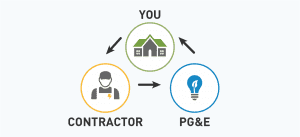We have said it before and will probably say it again: we work hard to make solar interconnection installation look simple. We work hard with our Energy Advisers and installation teams to ensure that everyone has the training and access to necessary resources to make the solar experience simple, fluid and enjoyable. However, not all steps of the solar installation process are in our control. Again, we work hard to be knowledgeable and prepared to deal even with aspects of the process that are out of our control, but knowledge and preparation are not always the solutions. One area where there is a lack of information, and is often doused in frustration, is interconnection. This short article is going to outline some key points about interconnection.
What Is Interconnection?

Photo Credit: PG&E
Interconnection is part of the process of getting a newly installed solar system connected to the grid. Typically, this process is pretty easy and, in states like California, mandatory. Interconnection is the physical and bureaucratic process of hooking a solar system up to the utility company’s wires. It’s not quite as simple as the standard one-way connection that non-solar homes have, because the electricity from your solar panels need to be converted and transmitted based on how much energy is produced by the system at any given time. The process is governed by rules called “standards” and “requirements” which determine the responsibilities of utility companies and homeowners in the interconnection process. Furthermore, this process is not regulated fully by the state, and small utilities make their own rules outlining demands for interconnection.
Hence, it is a necessary and mandatory aspect of a solar installation. However, it is not something a local solar installer can regulate or supersede. It is just a part of the solar installation process that your installer will navigate through, even if it takes some extra time.
How Does It Work?

Photo Credit: GoSunPro
A standard residential solar system installation takes an average of three days. Even through the final days of installation, a solar array can be fully functional. Once the system is set up and ready, the panels can already produce electricity, and the inverter is ready to convert the electricity produced by your panels into usable energy for your home. However, until the utility provides a letter giving the system “Permission To Operate” or most commonly referred to as PTO, the system cannot be turned on.
Part of the process for a solar installer is to work with the local utility. This process typically means the solar installer will complete an
- interconnection application
- schedule an engineering review,
- complete any necessary system upgrades
and wait for the utility to provide the PTO (Permission To Operate) letter from the utility.
So, What’s the Hold Up?

Photo Credit: Quality Enamel Signs
At the beginning of the article, I mentioned how there are aspects of the solar installation process that we have no control over. Obtaining PTO is one of those things.
Homeowners can see the swift installation process and how quickly and efficiently our team works together when it comes to system design, installation, permitting and financing. However, problems often arise when the install comes to a dead halt once the physical installation is complete. Applications and documentation for PTO have long been filed, and inspections have been scheduled.
And then we all wait.
Unfortunately, at this point, we – alongside our customers – are at the mercy and scheduling of the utility.
Often, when timing aligns, solar systems receive PTO within 48 hours of an installation being completed. Other times, there can be up to a 3 month wait. In one painfully frustrating instance, a homeowner had to wait for over 6 months due to utility process discrepancies.
What Do We Do?
Unfortunately, there is no easy solution. What we can and will do is ensure our paperwork is filed accurately and in a timely manner. We also work closely with the utility to learn about any sort of process changes or updates. Again, this allows us to be proactive in filing applications and requesting inspections.
We also spend a lot of time on the phone with local utilities. We want our customers to have great solar experiences. When the utility is the stop in the process, we want to make sure we are advocating for our customers and their access to clean energy production. This means we often spend hours on the phone attempting to determine when a home is going to get PTO.
We attempt to work directly with our local utilities as partners in the process. Our customers are shared customers with the utilities. We want the best for the customer, just as we can assume the utility does too.
Moving Forward
We continue to work with our utility partners to improve interconnection processes. Unfortunately, this is not something we can control. We are committed to an excellent solar experience and will be in constant communication with our customers if there are problems with the interconnection process. Luckily, more often than not, the process is fluid and our customers are up and running and connected to the grid, within a blink of an eye.
Related Articles:


Leave a Reply